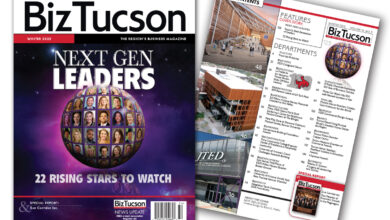
Museum Mainstay
Tucson Museum of Art Marks 100 Years
By Tiffany Kjos
The region’s oldest and largest museum has been a cultural beacon in Downtown Tucson thanks to the pioneering women who brought it to life, unwavering community support, and the visionaries ushering it forward.
The Tucson Museum of Art and Historic Block celebrates its centennial this year and, next spring, will mark 50 years at its current location at 140 N. Main Ave.
“The museum has always been supported by individuals in Tucson who believed so emphatically that arts add to the social life, the economic level and the vibrancy of the city,” said Norah Diedrich, the museum’s Jon and Linda Ender director and CEO. “For 100 years, it really has been about the people involved and their belief in what the arts can do for a community.”
TMA, accredited by the American Alliance of Museums, will welcome more than 70,000 visitors this year – a boon for downtown, said Felipe Garcia, president and CEO of Visit Tucson and a Downtown Tucson Partnership board member.
“A visitor to the museum is very likely to go, after visiting the museum, to a restaurant,” Garcia said. “And while in Downtown Tucson, they might discover another attraction and will either come back or stay longer.”
Diedrich is excited about the downtown’s momentum, including an uptick in overnight stays. “The number of visitors traveling to Tucson and staying in the downtown area has increased, which is a positive for all of the organizations located in Tucson’s downtown.”
Museum visitors can explore nearly 12,000 works of art spanning thousands of years, including indigenous art, art of the American West, Latin American art and modern and contemporary art. “Someone can walk in here and see work that was made two months ago, or they can see work that was made 3,000 years ago,” Diedrich said.
TMA was founded in 1924 by three Tucson Woman’s Club members who created the Tucson Fine Arts Association. Over its history, the museum has benefitted from numerous donors, most notably I. Michael Kasser and his wife Beth, who backed a 6,000-square-foot expansion for the museum and contributed extensively to its pre-Columbia and Latin American art collections.
“This organization has hopped all over downtown,” Diedrich said. “It has rented space at the Temple of Music and Art, we spent about 50 years on Franklin Street, and we’ve changed our names a couple of times.”
It settled on Main Avenue in 1975 when the city of Tucson leased an entire block to the museum which would become the Tucson Museum of Art and Historic Block. The site was one of the original territories of the Tohono O’odham, who were among Tucson’s earliest inhabitants, and was later part of the Presidio
“Art, culture, history, and heritage all intersect at this site. And that combination is exciting to people, particularly in a place like Tucson,” Diedrich said.
The block encompasses the museum, the Alice Chaiten Baker Center for Art Education and five historically significant buildings. La Casa Cordova houses the stunning El Nacimiento nativity display. Though it’s been closed since the COVID-19 pandemic, it will reopen for a Nov. 10 community block party marking the museum’s five decades on Main Avenue.
While celebrating its past, Diedrich is collaborating with community partners and others to forge its future. “We will be emphasizing the fact that this is not just an art museum – it is much more.”





